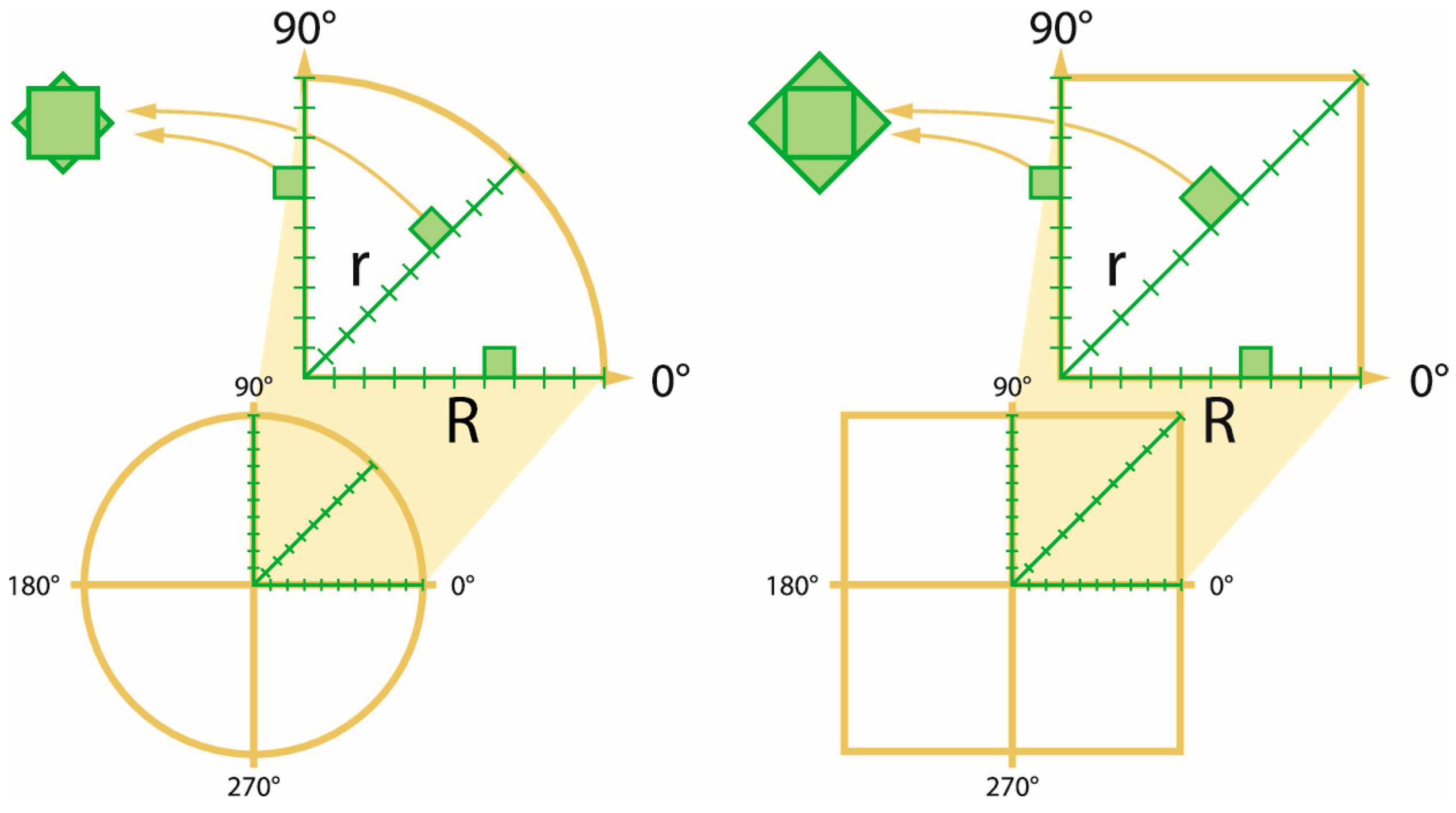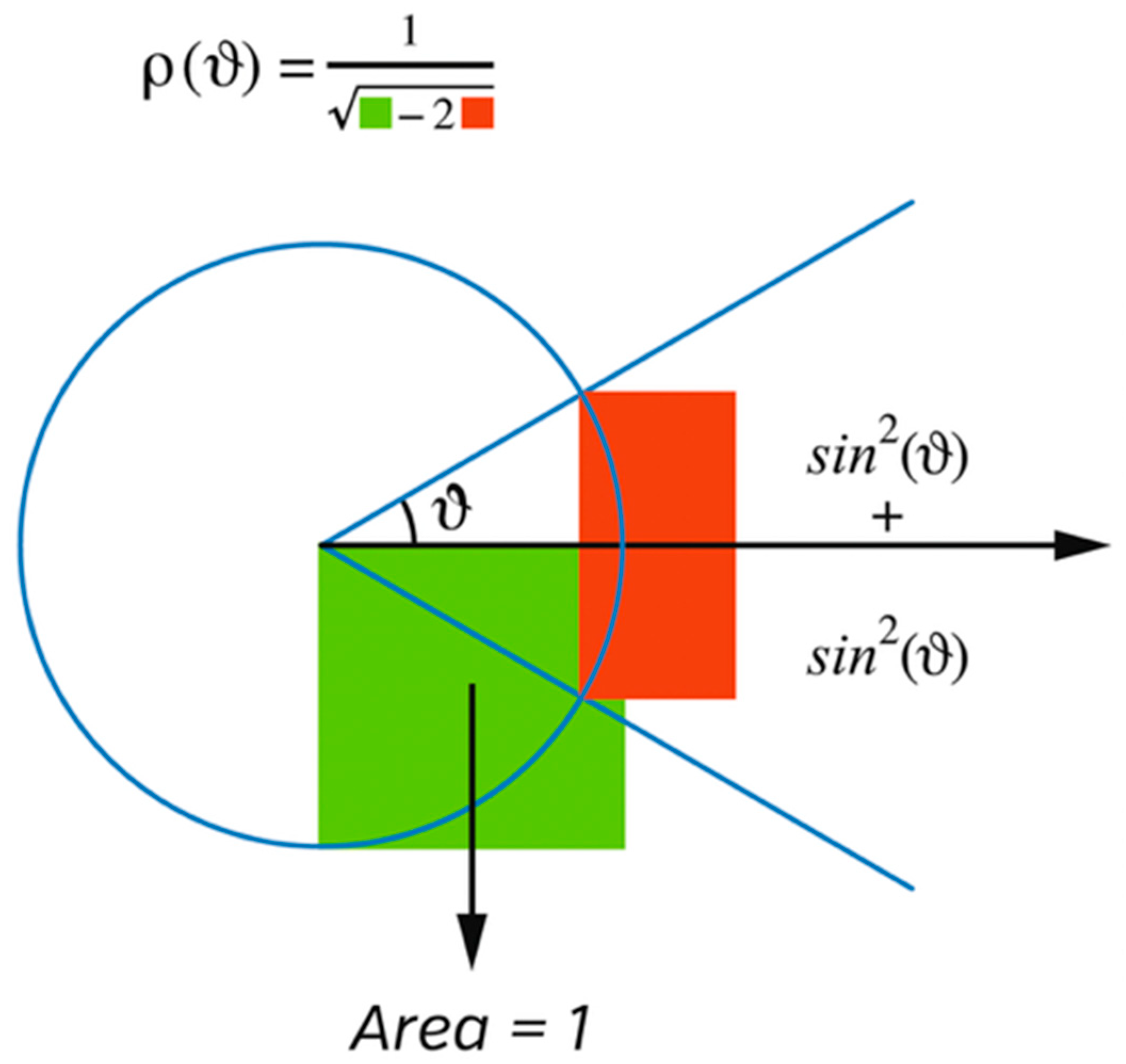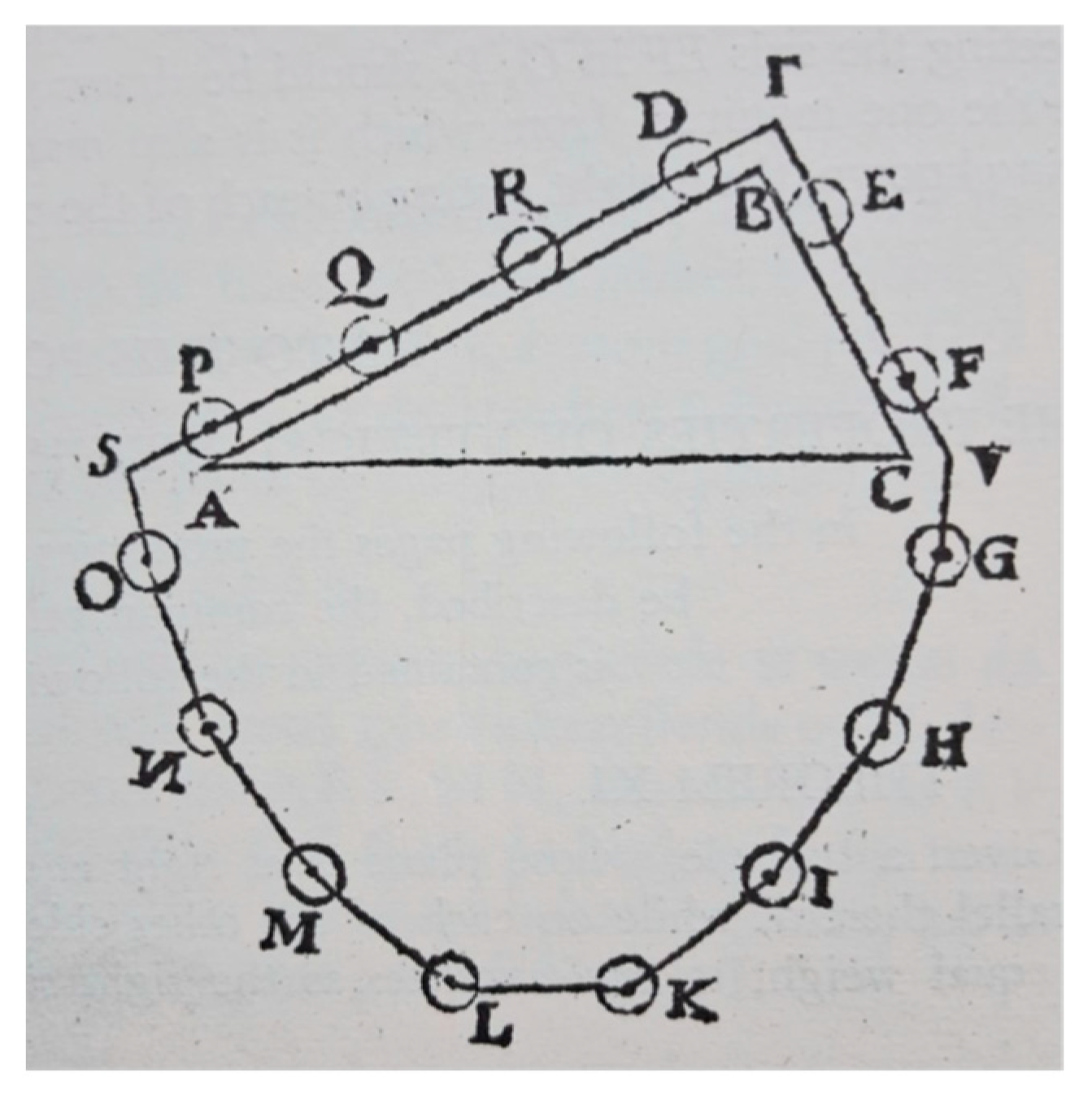A Point-Theory of Morphogenesis
Abstract
1. A Theory of Morphogenesis: The Challenges
2. A Plurality of Geometries for the Natural Sciences
- The circle as a measure of curvature by Isaac Newton. The extension to higher dimensions led to the General Theory of Relativity.
- Superposition of circles to describe complex phenomena. Ptolomy’s epicycles and the Fourier methods, which are ubiquitous in modern analysis, are mathematically equivalent [14].
- The introduction of complex numbers into this scheme led to quantum mechanics (“In this sense, quantum mechanics is a complexification of Ptolemy’s epicycles” [15]).
- Galilei and Kepler used conic sections (projectively equivalent to the circle) for the trajectories of projectiles and the orbits of planets.
- The generalisation of conic sections to higher-order, with superparabolas and supercircles (Lamé curves), adds one additional parameter to classic conic sections.
- The further generalisation of Lamé curves to any symmetry via the superformula has its roots in biology.
3. Continuous Transformations and Flexible Radii
3.1. Continuous Transformations
- The inscribed square is denoted as ϱ.
- A unit supercircle is denoted as ϱ.
- The starfish is denoted as ϱ.
- The circle is denoted a ϱ.
- A circle can be a shape without angles ( but also a square (), a pentagon (, or a pentagram ().
- A continuous transformation of a circle to a square or a pentagram () only requires a change in the shape parameters .
- The transformation of a circle into a square or pentagram does not require a change in the symmetry parameter and no symmetry is broken.
3.2. Flexible Radius
4. From Rigid to Ultra-Flex
5. A Formal Point-Theory of Morphogenesis
5.1. One Definition, Two Axioms, and Two Postulates
5.2. Remarks and Motivations
6. Numbers and Grids
7. Conclusions
Funding
Data Availability Statement
Acknowledgments
Conflicts of Interest
References
- Thompson, D.A.W. On Growth and Form; Cambridge University Press: Cambridge, UK, 1992. [Google Scholar]
- Thom, R. Structural Stability and Morphogenesis. An Outline of a General Theory of Models; Westview Press: Boulder, CO, USA, 1989. [Google Scholar]
- Arnold, V.I. On teaching mathematics. Russ. Math. Surv. 1998, 53, 229–236. [Google Scholar] [CrossRef]
- Berger, M. A Panoramic View of Riemannian Geometry; Springer: Berlin/Heidelberg, Germany, 2003. [Google Scholar]
- Chern, S.S. Foreword. In Handbook of Differential Geometry; Dillen, F.J.E., Verstraelen, L.C.A., Eds.; Elsevier: Amsterdam, The Netherlands, 2000; Volume I. [Google Scholar]
- Zalta, E. Abstract Objects: An Introduction to Axiomatic Metaphysics (No. 160); Springer: Berlin/Heidelberg, Germany, 1983. [Google Scholar]
- Grenander, U. Elements of Pattern Theory; JHU Press: Baltimore, MD, USA, 1996. [Google Scholar]
- Grenander, U. Calculus of Ideas, A: A Mathematical Study of Human Thought; World Scientific: Singapore, 2012. [Google Scholar]
- Mumford, D. Pattern Theory: A Unifying Perspective. In Proceedings of the First European Congress of Mathematics, Paris, France, 6–10 July 1992; Volume I Invited Lectures (Part 1). Birkhäuser: Basel, Switzerland, 1994; pp. 187–224. [Google Scholar]
- Mumford, D.; Desolneux, A. Pattern Theory: The Stochastic Analysis of Real-World Signals; CRC Press: Boca Raton, FL, USA, 2010. [Google Scholar]
- Van Oystaeyen, F.; Gielis, J.; Ceulemans, R. Mathematical aspects of plant modeling. Scr. Bot. Belg. 1996, 13, 7–27. [Google Scholar]
- Gielis, J.; Caratelli, D.; Haesen, S.; Ricci, P.E. Rational Mechanics and Science Rationelle Unique. In The Genius of Archimedes—23 Centuries of Influence on Mathematics, Science and Engineering: Proceedings of an International Conference Held at Syracuse, Italy, 8–10 June 2010; Springer: Dordrecht, The Netherlands, 2010; pp. 29–43. [Google Scholar]
- Fox Keller, E. (Ed.) A Feeling for the Organism. In The Life and Work of Barbara McClintock; Freeman: New York, NY, USA, 1983. [Google Scholar]
- Boccaletti, D. From the epicycles of the Greeks to Kepler’s ellipse and the breakdown of the circle paradigm. In Proceedings of the Cosmology Through Time: Ancient and Modern Cosmology in the Meditteranean Area, Monte Porzio Catone (Rome), Italy, 18–20 June 2001; Available online: https://www.researchgate.net/profile/Dino-Boccaletti-2/publication/2166565_From_the_epicycles_of_the_Greeks_to_Kepler’s_ellipse_-_The_breakdown_of_the_circle_paradigm/links/00b7d53a19735d11e7000000/From-the-epicycles-of-the-Greeks-to-Keplers-ellipse-The-breakdown-of-the-circle-paradigm.pdf (accessed on 9 September 2025).
- Manin, Y.I. Time and Periodicity from Ptolomy to Schrödinger: Paradigm shifts versus continuity in the history of Mathematics. In Geometry in History; Springer International Publishing: Berlin/Heidelberg, Germany, 2019; pp. 129–138. [Google Scholar]
- Feynman, R.P. Feynman Lectures; CRC Press: Boca Raton, FL, USA, 1963. [Google Scholar]
- Chern, S.S. Finsler geometry is just Riemannian geometry without the quadratic restriction. In Notices of the AMS; American Mathematical Society: Providence, RI, USA, 1996; pp. 959–963. [Google Scholar]
- Child, J.M. The Geometrical Lectures of Isaac Barrow. The Open Court Series of Classics of Science and Philosophy, N°3; The Open Court Publishing Company: Chicago, IL, USA; London, UK, 1916. [Google Scholar]
- Lamé, G. Examen des Différentes Méthodes Employées Pour Résoudre les Problèmes De Géométrie; Mme. Ve. Courcier, Imprimeur-Libraire: Paris, France, 1818. [Google Scholar]
- Verstraelen, L. A concise mini history of geometry. Kragujev. J. Math. 2014, 38, 5–21. [Google Scholar] [CrossRef]
- Shi, P.J.; Huang, J.G.; Hui, C.; Grissino-Mayer, H.D.; Tardif, J.C.; Zhai, L.H.; Wang, F.S.; Li, B.L. Capturing spiral radial growth of conifers using the superellipse to model tree-ring geometric shape. Front. Plant Sci. 2015, 6, 856. [Google Scholar] [CrossRef]
- Huang, W.; Ma, K.; Gladish, D.K. Ellipse or superellipse for tree-ring geometries? Evidence from six conifer species. Trees 2024, 38, 1403–1413. [Google Scholar] [CrossRef]
- Huang, W.; Ma, K.; Tan, J.; Wei, M.; Lu, Y. Superellipse Equation Describing the Geometries of Abies alba Tree Rings. Plants 2024, 13, 3487. [Google Scholar] [CrossRef] [PubMed]
- Li, Y.; Niklas, K.J.; Gielis, J.; Niinemets, Ü.; Schrader, J.; Wang, R.; Shi, P. An elliptical blade is not a true ellipse, but a superellipse–Evidence from two Michelia species. J. For. Res. 2022, 33, 1341–1348. [Google Scholar] [CrossRef]
- Shi, P.; Ratkowsky, D.A.; Li, Y.; Zhang, L.; Lin, S.; Gielis, J. A general leaf area geometric formula exists for plants—Evidence from the simplified Gielis equation. Forests 2018, 9, 714. [Google Scholar] [CrossRef]
- Gielis, J. De Uitvinding van de Cirkel (Dutch, 2001); Inventing the Circle (English, 2003); Geniaal Publishing: Antwerp, Belgium, 2001. [Google Scholar]
- Huang, W.; Li, Y.; Niklas, K.J.; Gielis, J.; Ding, Y.; Cao, L.; Shi, P. A superellipse with deformation and its application in describing the cross-sectional shapes of a square bamboo. Symmetry 2020, 12, 2073. [Google Scholar] [CrossRef]
- Gielis, J. A generic geometric transformation that unifies a wide range of natural and abstract shapes. Am. J. Bot. 2003, 90, 333–338. [Google Scholar] [CrossRef]
- Gielis, J. The Geometrical Beauty of Plants; Atlantis/Springer: Berlin/Heidelberg, Germany, 2017. [Google Scholar]
- Gielis, J.; Haesen, S.; Verstraelen, L. Universal natural shapes: From the super eggs of Piet Hein to the cosmic egg of Georges Lemaître. Kragujev. J. Math. 2005, 28, 57–68. [Google Scholar]
- Koiso, M.; Palmer, B. Equilibria for anisotropic surface energies and the Gielis formula. Forma (Jpn. Soc. Form) 2008, 23, 1–8. [Google Scholar]
- Palmer, B.; Pámpano, A. Classification of planar anisotropic elasticae. Growth Form 2020, 1, 33–40. [Google Scholar] [CrossRef][Green Version]
- Natalini, P.; Patrizi, R.; Ricci, P.E. The Dirichlet problem for the Laplace equation in a starlike domain of a Riemann surface. Numer. Algorithms 2008, 49, 299–313. [Google Scholar] [CrossRef]
- Caratelli, D.; Ricci, P.E. The Dirichlet problem for the Laplace equation in a starlike domain. In Lecture Notes TICMI; Bucharest University Press: Tbilisi, Georgia, 2009; Volume 10, pp. 35–49. [Google Scholar]
- Gielis, J.; Caratelli, D.; Fougerolle, Y.; Ricci, P.E.; Tavkelidze, I.; Gerats, T. Universal natural shapes: From unifying shape description to simple methods for shape analysis and boundary value problems. PLoS ONE 2012, 7, e29324. [Google Scholar] [CrossRef]
- Ricci, P.E.; Gielis, J. From Pythagoras to Fourier and from Geometry to Nature; Athena Publishing: Amsterdam, The Netherlands, 2022; ISBN 978-90-832323-1-7. [Google Scholar]
- Javaloyes, M.Á.; Pendás-Recondo, E.; Sánchez, M. Gielis superformula and wildfire models. In Proceedings of the ISSBG 2023, Online, 4–5 December 2023; Geniaal Press: Antwerpen, Belgium, 2024. [Google Scholar]
- Yajima, T.; Nagahama, H. Finsler geometry of seismic ray path in anisotropic media. Proc. R. Soc. A 2009, 469, 1763. [Google Scholar] [CrossRef]
- Ermiş, T.; Şen, A.O.; Gielis, J. A New Approach to Circular Inversion in l 1-Normed Spaces. Symmetry 2024, 16, 874. [Google Scholar]
- Özdemir, Z.; Parlak, E. Superquadric Motion and Superquadric Hyperbolic Split Quaternion Algebra Via Gielis Formula. Math. Methods Appl. Sci. 2025. [Google Scholar] [CrossRef]
- Parlak, E.; Özdemir, Z. Superelliptic motion and superelliptic quaternions via Gielis formula. Phys. Scr. 2025, in press. [Google Scholar] [CrossRef]
- Haesen, S.; Nistor, A.; Verstraelen, L. On growth and form and geometry I. Kragujev. J. Math. 2012, 36, 5–25. [Google Scholar]
- Gielis, J.; Shi, P.; Beirinckx, B.; Caratelli, D.; Ricci, P.E. Lamé-Gielis curves in biology and geometry. In Proceedings of the International Conference Riemannian Geometry and Applications (RIGA 2021), Bucharest, Romania, 15–17 January 2021. [Google Scholar]
- Mescia, L.; Bia, P.; Caratelli, D.; Chiapperino, M.A.; Stukach, O.; Gielis, J. Electromagnetic mathematical modeling of 3D supershaped dielectric lens antennas. Math. Probl. Eng. 2016, 2016, 8130160. [Google Scholar] [CrossRef]
- van Coevorden, C.D.J.; Gielis, J.; Caratelli, D. Application of Gielis transformation to the design of metamaterial structures. J. Phys. Conf. Ser. 2018, 963, 012008. [Google Scholar] [CrossRef]
- Geerarts, J.M.; Theis, G.; Smolders, A.B.; Caratelli, D. Constrained deterministic synthesis of conformal supershaped antenna arrays. IEEE Trans. Antennas Propag. 2023, 71, 8726–8738. [Google Scholar] [CrossRef]
- Leung, K.W.; Huang, C.T.; Fang, Z.; Lu, K.; Yang, N. Wideband Circularly Polarized Horn Antenna with Twisted Ridges of Gielis Super-Formula Contour. IEEE Trans. Antennas Propag. 2024, 73, 1197–1202. [Google Scholar] [CrossRef]
- Gielis, J.; Beirinckx, B.; Bastiaens, E. Superquadrics with rational and irrational symmetry. In Proceedings of the Eighth ACM symposium on Solid Modeling and Applications, Seattle, WT, USA, 16–20 June 2003; pp. 262–265. [Google Scholar]
- Fougerolle, Y.D.; Gribok, A.; Foufou, S.; Truchetet, F.; Abidi, M.A. Boolean operations with implicit and parametric representation of primitives using R-functions. IEEE Trans. Vis. Comput. Graph. 2005, 11, 529–539. [Google Scholar] [CrossRef]
- Nessi, A.; Stanković, T. Topology, shape, and size optimization of additively manufactured lattice structures based on the superformula. In Proceedings of the International Design Engineering Technical Conferences and Computers and Information in Engineering Conference, Quebec City, QC, Canada, 26–29 August 2018; American Society of Mechanical Engineers: New York, NY, USA, 2018; Volume 51753, p. V02AT03A042. [Google Scholar]
- Rodrigo, J.A.; Alieva, T. Polymorphic beams and Nature inspired circuits for optical current. Sci. Rep. 2016, 6, 35341. [Google Scholar] [CrossRef]
- Codemard, C.A.; Malinowski, A.; Zervas, M.N. Numerical optimisation of pump absorption in doped double-clad fiber with transverse and longitudinal perturbation. In Proceedings of the Fiber Lasers XIV: Technology and Systems, San Francisco, CA, USA, 28 January–2 February 2017; SPIE: Bellingham, WT, USA, 2017; Volume 10083, pp. 208–214. [Google Scholar]
- Hashemi, P.; Yaghooti, E.; Babaei, F. Localized surface plasmons in disk supershape shell nanoparticles. J. Opt. Soc. Am. B 2025, 42, 1366–1376. [Google Scholar] [CrossRef]
- Gielis, J.; Caratelli, D.; Moreno de Jong van Coevorden, C.; Ricci, P.E. The common descent of biological shape description and special functions. In Proceedings of the International Conference on Differential & Difference Equations and Applications, Lisbon, Portugal, 5–9 June 2017; Springer International Publishing: Cham, Switzerland, 2017; pp. 119–131. [Google Scholar]
- Chapman, D.; Bunyard, R.; Gielis, J. Pitch and Timbre of Supershape Oscillators. Symmetry Cult. Sci. 2024, 35, 299–302. [Google Scholar] [CrossRef]
- Stevin, S. The Principal Works of Simon Stevin, Vol I Mechanics; Dijksterhuis, E.J., Ed.; CV Swets & Zeitlinger: Amsterdam, The Netherlands, 1955. [Google Scholar]
- Gielis, J.; Natalini, P.; Ricci, P.E. A note about generalized forms of the Gielis formula. In Modeling in Mathematics: Proceedings of the Second Tbilisi-Salerno Workshop on Modeling in Mathematics; Atlantis Press: Dordrecht, The Netherlands, 2017; pp. 107–116. [Google Scholar]
- Hersh, R. What Is Mathematics, Really? Oxford University Press: Oxford, UK, 1999. [Google Scholar]
- Guitart, R. Les coordonnées curvilignes de Gabriel Lamé–Représentation des situations physiques et nouveaux objets mathématiques. Bulletin de la Sabix. Société Amis Bibliothèque l’Histoire l’École Polytech. 2009, 44, 119–129. [Google Scholar]
- Van Oystaeyen, F. Time-Ordered Momentary States of the Universe and a Dynamic Generic Model of Reality: Étale Over a Dynamic Non-Commutative Geometry. Growth Form 2023, 4, 21–35. [Google Scholar] [CrossRef]
- Hilger, S. Analysis on measure chains—A unified approach to continuous and discrete calculus. Results Math. 1990, 18, 18–56. [Google Scholar] [CrossRef]
- Bohner, M.; Georgiev, S.G. Multivariable Dynamic Calculus on Time Scales; Springer: Cham, Switzerland, 2016; pp. 449–515. [Google Scholar]
- Gielis, J.; Grigolia, R. Lamé curves and Rvachev’s R-functions. In Reports of Enlarged Sessions of the Seminar of I.N. Vekua Institute of Applied Mathematics; Tbilisi University Press: Tbilisi, Georgia, 2022; Volume 37, pp. 1–4. [Google Scholar]
- Grigolia, R. Three-Valued Gödel Logic With Constants and Involution for Application to R-Functions. In Proceedings of the 1st International Symposium on Square Bamboos and the Geometree (ISSBG 2022), Online, 21–22 November 2022; Athena Publishing: Amsterdam, The Netherlands, 2023; pp. 47–51. [Google Scholar]
- Gielis, J.; Caratelli, D.; Tavkhelidze, I. Rational Science, Unique and Simple. In Proceedings of the ISSBG 2023, Online, 4–5 December 2023; Geniaal Press: Antwerpen, Belgium, 2024. [Google Scholar]
- Gielis, J.; Tavkhelidze, I.; Ricci, P.E. Generalized Möbius-Listing bodies and the heart. Rom. J. Math. Comput. Sci. 2023, 13, 58–70. [Google Scholar]
- Gielis, J. Conquering Mount Improbable. In Proceedings of the 1st International Symposium on Square Bamboos and the Geometree (ISSBG 2022), Online, 21–22 November 2022; pp. 153–173. [Google Scholar]
- Palmer, B. Construction of Equilibria with Symmetry for Anisotropic Energy Functionals. In Proceedings of the 1st International Symposium on Square Bamboos and the Geometree (ISSBG 2022), Online, 21–22 November 2022; Athena Publishing: Amsterdam, The Netherlands, 2023. [Google Scholar]
- Licciardi, S. Umbral Calculus and New Trigonometries. In Proceedings of the 1st International Symposium on Square Bamboos and the Geometree (ISSBG 2022), Online, 21–22 November 2022; pp. 95–106. [Google Scholar]
- He, M. Beyond D’Arcy Thompson’s ‘Theory of Transformations’ and ‘Laws of Growth’: Future Challenges of Transforming “Invisible” to “Visible”. In Proceedings of the International Symposium Square Bamboos and the Geometree, Online, 21–22 November 2022; Athena Publishing: Amsterdam, The Netherlands, 2023; p. 85. [Google Scholar]
- Aristotle, Metaphysics, Book 1. Available online: https://www.oxfordscholarlyeditions.com/display/10.1093/actrade/9780198847762.book.1/actrade-9780198847762-book-1 (accessed on 9 September 2025).




Disclaimer/Publisher’s Note: The statements, opinions and data contained in all publications are solely those of the individual author(s) and contributor(s) and not of MDPI and/or the editor(s). MDPI and/or the editor(s) disclaim responsibility for any injury to people or property resulting from any ideas, methods, instructions or products referred to in the content. |
© 2025 by the author. Licensee MDPI, Basel, Switzerland. This article is an open access article distributed under the terms and conditions of the Creative Commons Attribution (CC BY) license (https://creativecommons.org/licenses/by/4.0/).
Share and Cite
Gielis, J. A Point-Theory of Morphogenesis. Mathematics 2025, 13, 3076. https://doi.org/10.3390/math13193076
Gielis J. A Point-Theory of Morphogenesis. Mathematics. 2025; 13(19):3076. https://doi.org/10.3390/math13193076
Chicago/Turabian StyleGielis, Johan. 2025. "A Point-Theory of Morphogenesis" Mathematics 13, no. 19: 3076. https://doi.org/10.3390/math13193076
APA StyleGielis, J. (2025). A Point-Theory of Morphogenesis. Mathematics, 13(19), 3076. https://doi.org/10.3390/math13193076





